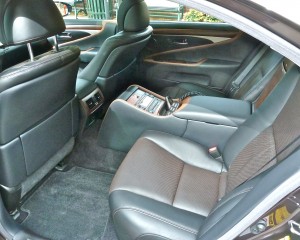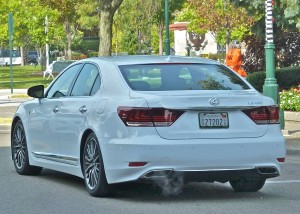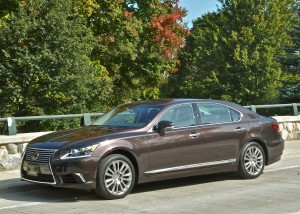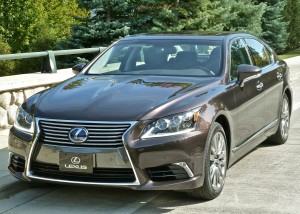Lexus LS packs punch with its luxury
By John Gilbert
BIRMINGHAM, MICH. — There can be no better measuring stick of how far the Lexus brand has come in its 13-year history than working through all the various models until you come face to face with the new 2013 Lexus LS sedans.
The new car is loaded with all the imaginable electronic gizmos and features for which Lexus has become known, and it is fully pleasurable to drive or to ride in, with excellent power that always is combined with luxurious touches throughout. There is even a breakthrough hybrid model, which is not unusual for Toyota and its luxury brand, and a special sporty model — which clearly IS unusual for Toyota, and rare for Lexus. Adding high-performance capabilities to the always luxurious LS models lifts the car to true, German sports-luxury sedan potential, and LS prices are expected to be from $70,000 to $120,000.
The new car’s styling alterations include high-intensity headlights, or optional LED headlights, which are standard on the 600h hybrid. The redesigned rear features horizontal taillights with inserts that look like three “Ls” stacked to either stand for Lexus, or Minnesotans can claim they’re hockey sticks. The restyled exterior carries over to the interior, where a redesigned dashboard features a huge, 12.3-inch navigation screen, positioned higher to be nearer to eye-level. It separates to allow multiple segments, such as a map, audio settings and climate control, all at the same time.
Everything is aimed at reducing driver fatigue. The center-stack and console controls can be operated without leaning out of the driver seat. That driver seat is a 16-way power unit, 12-way for the front passenger. The seat structure is of a new and different foam that cradles the pelvis in a lower seating position. The rear seat also has more luxury and controllable climate switches, and the elongated executive class has a center console, and a right-side power-rising ottoman.
LS buyers traditionally have appreciated special items that competitors lack. In the new model, you have climate control, and a climate controlled seat. You can set the climate control for 70 degrees, for example, but on a frigid night it will take a while for the interior air to reach 70. In the LS, a sensor in the seat recognizes your body heat’s temperature, and the steering wheel and seat heat up almost immediately to your body’s temperature. The clever plan is that if your hands and body feel warm, you’ll feel warm and it won’t matter if it takes a while for the inside air to reach 70. The device works on all four seats, and the “climate control concierge” lets you set all four seats individually.

LS600h L has enormous rear seat with separate console, and individually body-heat-sensing seat heaters.
Among the interior choices of different leathers and types of wood, the lighter bamboo that has proven popular in the new GS models is available. The real wood sheets that are installed as interior trim requires seven processes over seven days. And the real wood that encircles the steering wheel is crafted in strips that are just wide enough to wrap around the wheel. That steering wheel construction takes 67 processes and 38 days, which makes you realize that much attention to detail pretty well assures that every detail is carefully crafted.
Appreciation of the new Lexus LS460 is easy, just by looking over the car and taking it for a drive around any suburban area, or by spending an afternoon reading its extensive list of features. But full appreciation requires going back to the first Lexus LS, as a 1990 model. At its inception, Lexus stepped above and beyond the Toyota brand, which was very successful but didn’t have a true luxury car. That meant all those satisfied Camry buyers looking for something more luxurious than an Avalon had to look to Germany, for a Mercedes, BMW or Audi.
Toyota did better than just build a luxury car. It built a whole luxury brand, called Lexus. That first LS was a very interesting and impressive Mercedes wannabe. It was larger, and had a smooth, refined and understated look of luxury not unlike the concept that put Mercedes at the top of the luxury list. The first Lexus LS had most of the Mercedes attributes for significantly less money. Toyota also offered an entry-level ES model, just to give customers a chance to spend even less and get something more.
At the same time, Lexus established itself for outstanding service providing true satisfaction to every customer, and the best competitive nameplates were wise to start adopting some of Lexus dealership ideas.
Lexus has since sprouted all sorts of new models and variations, which has evolved to include a batch of very successful SUVs that include the largest LX models on down to the RX, the midsize crossover that has become the largest-selling vehicle in the whole Lexus line.
The ES remains, and it has become far more than merely a stretched and padded Camry, and the GS has emerged as a higher-performing segment of the Lexus line. An all-new GS was introduced earlier this year, displaying a radically changed appearance, fronted by what Lexus officials called a “spindle” grille, apparently because it resembles a spindle sitting on its base, with a pinched-in line that takes the grille in and back out. The GS has a lot of power, and it also has an F-Sport model that takes it up to track-worthy performance, with all-wheel driven offered, and, at the top of the scale, a hybrid version.
The popular ES followed with its new model, which is presently the focal point of Lexus promotion, and while it varies from the GS and LS by starting with front-wheel drive, it also has what has since been identified as the new Lexus signature spindle grille.
That brought us to the northern Detroit suburb of Birmingham at the end of September, where Lexus unveiled the new 2013 LS sedans — the top-of-the-line flagship that has always been loaded with features even while remaining sedate, from the 1990 original, to the 1995 second generation, 2001 third generation, and 2007 fourth generation.
The fifth generation LS breaks away from the form chart. It boldly flashes the new spindle grille, and has smoothly flowing lines — with a coefficient of aerodynamic drag at a mere 0.26 — with some distinctly sporty overtones. None of the sportiness detracts in any way from the luxury ideas, but it proves that LS buyers can now have their opulence and flaunt it, with a stab at the gas pedal, or a flick of the steering wheel.
Tim Morrison, whose title is vice president of Lexus sales and dealer development, but who pretty much oversees all Lexus development, said that since corporate heir Akio Toyoda took over as president two years ago, the much-scorned absence of performance-oriented cars was destined to disappear.
The standard 4.6-liter V8, with its dual overhead camshafts and both port and direct injection produces 386 horsepower at 6,400 RPMs, an increase of 6, with 367 foot-pounds of torque at 4,100 RPMs. If you select an all-wheel drive option — a huge asset for winter-driving folks who still want their luxury cars — the horsepower drops to 359. Fuel economy on the large sedan, which ranges from 4,233 pounds to a whopping 4,695 depending on whether you choose the normal car or the elongated model with AWD, is comparatively modest, with 16 city/24 highway for rear-drive versions, to 16/23 for the AWD models.
Performance is strong, with 0-60 times of a mere 5.4 seconds. The 8-speed automatic transmission has been geared for lower first and second gears to enhance acceleration, and higher third through eighth gears for better mileage while cruising.
Handling of the big LS is impressive, without much leaning and with precise stability going around corners. And that’s the normal, garden-variety LS. Move up to the F-Sport, a designation which almost seems alien to the luxury-biased LS, and you get the ability to stiffen the suspension, firm up the steering and get more performance from the car’s cornering ability. Once again, it doesn’t ever approach being so firm as to conjure up the idea of harshness, it just improves handling agility.
The LS can be obtained with either coil springs or air suspension. The LS with coil springs over the shock absorbers has adjustable modes of Eco, Normal, and Sport. Normal is about what you’d expect from an LS, while Eco is aimed at fuel savings, smoothing out the electronic throttle control and even modifying air-conditioning force. Sport mode adjusts throttle control and the electric power steering, and the instrumentation lighting changes from blue to red.
If you buy the F-Sport version of the LS, you can select rear-wheel drive with a rear Torsen differential that apportions power left or right as your driving calls for, or all-wheel drive, which has a center Torsen differential that splits torque front to rear as well as left-right. With air suspension, your choices are Eco, Comfort, Normal, Sport-S, and Sport-S-Plus. Normal is just fine, and Eco again gives you adequate but lessened performance. Comfort is the most compliant ride with reduced power, and Sport-S increases throttle input and gets you the red instrumentation. Sport-S-Plus additionally heightens the shift strategy to what is called Sport-D, firms up the suspension, and tightens the steering.
The air suspension can electrically tighten or soften the suspension by stiffening the outside suspension via a gyro-yaw sensor that can change the settings on all four corners. There is an impressive engineering feat in the 18-inch alloy wheels, which have hollow chambers that allow air into the chamber. When you hit a pothole, the frequency of the specially designed KYB shock absorber squeezes air into the chamber to briefly but instantly soften the impact.
Additionally, an active stabilizer system applies torque to the stabilizer bar, from input gained from lateral acceleration, wheel speed, steering agility, and G-force sensors.
The F-Sport visually has a few exterior variations, including a gloss-black grille and a few little air-scoop and rear valance additions. The F-Sport sits 20 mm. lower than the coil-spring cars, and the interior trim is mostly aluminum instead of wood, with the rich leather seats. Side bolsters on the bucket seats are higher, and steering wheel paddles for manually overriding the 8-speed automatic are standard.
The LS 600h is the first hybrid that combines the electric power in conjunction with a V8, and the performance concept continues with the hybrid, which starts out with the 5.0-liter V8 instead of the 4.6. The 5.0 has 389 horsepower at 6,400 RPMs and 385 foot-pounds of torque at 4,000, and it gets a 49-horsepower boost from its 240-cell Panasonic-designed nickel-metal-hydride battery pack, to attain 438 horsepower.
Toyota continues to believe in the reliability of nickel-metal-hydride, while most competitors have determined that lithium-ion battery packs are lighter, smaller and hold more power longer. In the Lexus LS400h, the first all-wheel-drive V8 hybrid, combines with an electronic CVT (continuously variable transmission) and coordinates with two motor generators. Motor Generator 1 (MG-1) starts the gas engine and becomes a generator to produce electricity to recharge the hybrid battery as well as power MG-2, which controls regenerative brake activation and converts kinetic energy to electricity to recharge the hybrid battery.
An inverter is required to convert direct current to alternating current to drive MG-1 and MG-2, and it also pushes the 288 volt DC current to 650 DC volts. After boosting the voltage, the inverter converts DC to ac to power the vehicle. The whole process is almost mirrored when MG-1 and MG-2 act as generators, and the inverter converts AC into the maximum 650 DC volts, then activates the boost converter to reduce voltage to 288 volts DC to recharge the hybrid battery.
Anyone still think the Toyota hybrid system is simple?
Instead of merely using electrical power to increase gas mileage, the LS600h uses it for power, and the loaded vehicle I drove had all-wheel drive and tremendous outputs of power, which might be why its EPA fuel estimates are only 19 city and 23 mpg highway. The all-wheel drive system has a 60/40 rear axle bias, which can adjust from 52/48 to 68/32, depending on slippage and traction demands.
With prices expected to be up to and over $100,000, I asked Morrison about the similar family face of the new Lexus models. Would Lexus mind if someone who wanted an LS460 instead bought a $60,000 GS350? “We don’t care,” he said, “as long as we can keep ’em in the family.”
Comments
Tell me what you're thinking...
and oh, if you want a pic to show with your comment, go get a gravatar!






 John Gilbert is a lifetime Minnesotan and career journalist, specializing in cars and sports during and since spending 30 years at the Minneapolis Tribune, now the Star Tribune. More recently, he has continued translating the high-tech world of autos and sharing his passionate insights as a freelance writer/photographer/broadcaster. A member of the prestigious North American Car and Truck of the Year jury since 1993. John can be heard Monday-Friday from 9-11am on 610 KDAL(www.kdal610.com) on the "John Gilbert Show," and writes a column in the Duluth Reader.
John Gilbert is a lifetime Minnesotan and career journalist, specializing in cars and sports during and since spending 30 years at the Minneapolis Tribune, now the Star Tribune. More recently, he has continued translating the high-tech world of autos and sharing his passionate insights as a freelance writer/photographer/broadcaster. A member of the prestigious North American Car and Truck of the Year jury since 1993. John can be heard Monday-Friday from 9-11am on 610 KDAL(www.kdal610.com) on the "John Gilbert Show," and writes a column in the Duluth Reader.